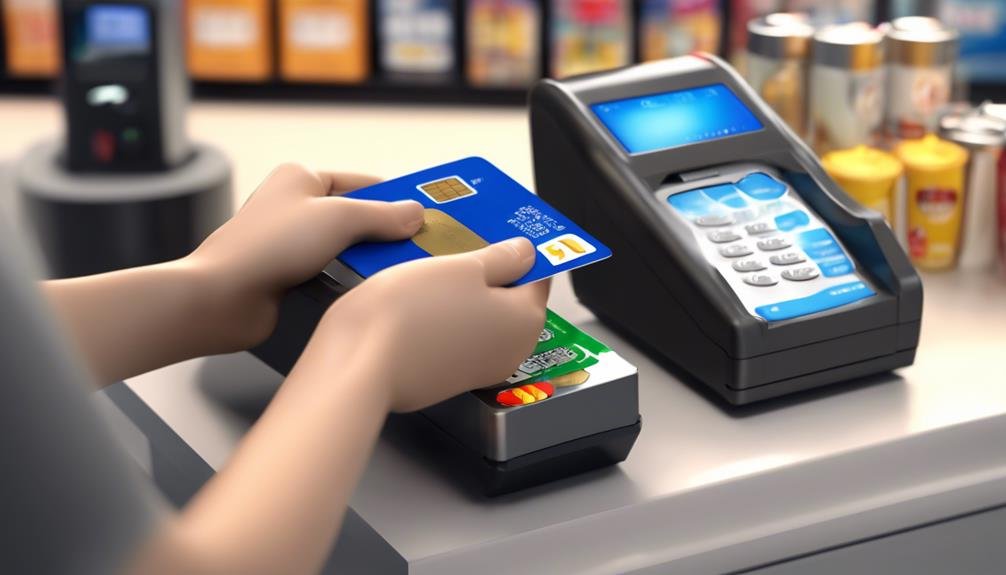Chip Card: Definition, How It Works, Types, and Benefits
Chip cards, or EMV cards, feature embedded microchips that enhance transaction security globally. These cards rely on chip technology to encrypt data, reducing the risk of fraud and breaches. Chip-and-PIN cards require a PIN for authorization, prevalent in Europe for added security, while chip-and-signature cards use both a magnetic stripe and microchip. The benefits of chip cards are profound, offering advanced security, fraud prevention, and a streamlined payment process. Their superior protection compared to magnetic stripe cards makes them a preferred choice for secure transactions. Learn more about the functionality, types, and benefits of chip cards for enhanced financial security.
Key Takeaways
- Chip cards have a microchip for data protection and fraud prevention.
- Types include Chip-and-PIN for enhanced security and Chip-and-signature for signature verification.
- They offer global standardization, secure transactions, and reduced fraud risk.
- Benefits include enhanced security, unique transaction codes, and peace of mind.
- Chip cards surpass magnetic stripe cards in security, encryption, and fraud prevention.
Chip Card Definition
The chip card, a standard-size plastic payment card equipped with an embedded microchip and magnetic stripe, revolutionized transaction security in the financial industry.
Chip card technology greatly enhances data security by encrypting information for secure transactions at chip-enabled terminals. This technology adds an important layer of security that makes skimming more challenging and reduces the risk of fraud from data breaches.
Chip cards also offer advantages such as fraud prevention monitoring by card providers, limiting liability for fraudulent usage, and enhancing consumer protection. By globally standardizing debit and credit transactions, chip cards have become a cornerstone in the fight against counterfeit card fraud.
Chip Card Functionality
Enhancing transaction security and data protection, the functionality of chip cards lies in their embedded microchip and magnetic stripe technology. Chip card technology advancements have revolutionized global transactions, providing enhanced security measures and reducing the risk of fraud. The impact of chip cards on global transactions is significant, as they offer a standardized approach to secure debit and credit transactions worldwide. Below is a table highlighting key aspects of chip card functionality:
| Chip Card Functionality | Description |
|---|---|
| Enhanced Security | Embedded microchip technology enhances data protection during transactions. |
| Global Standardization | Standardized approach to debit and credit transactions for increased security globally. |
| Fraud Prevention Measures | Chip technology helps prevent fraud from data breaches and counterfeiting. |
| Transaction Approval | Cardholders insert the chip card into a compatible terminal for transaction authorization. |
| PIN or Signature | Depending on the card type, users may need to enter a PIN or provide a signature for transactions. |
Chip Card Types
Analyzing the categorization of chip card variants provides insight into the diverse security features and transaction methods associated with different types of chip cards. Chip-and-PIN cards require a personal identification number (PIN) for transaction authorization, offering enhanced security measures. This type of card is prevalent in Europe and other regions, aiding in the prevention of fraudulent activities and providing more protection compared to traditional magnetic stripe cards.
On the other hand, chip-and-signature cards encode information in both the magnetic stripe and microchip, allowing for signature verification during transactions. While offering improved security features, chip-and-signature cards are generally considered less secure than chip-and-PIN cards and are commonly used in the United States.
Chip Card Usage
Continuing the exploration of chip card functionality, understanding the practical application and utilization of chip cards in various transaction scenarios provides valuable insights into their widespread usage and security benefits.
- Enhanced Security: Chip card technology provides advanced security features, reducing the risk of fraudulent activities during transactions.
- Global Acceptance: Chip cards are widely accepted across different regions, offering convenience and reliability for international travelers.
- Transaction Speed: Chip cards enable quick and secure transactions at chip-enabled terminals, streamlining the payment process.
- Adoption Growth: The adoption of chip cards continues to increase, with more businesses and financial institutions embracing this technology for its numerous advantages in safeguarding sensitive data and preventing unauthorized access.
Benefits of Chip Cards
Chip cards offer significant advantages in enhancing transaction security and safeguarding sensitive financial information during payment processes. Increased security is a key benefit of chip cards, as the embedded microchip generates a unique code for each transaction, making it extremely difficult for fraudsters to replicate or clone the card. This technology encrypts data, reducing the risk of data breaches and counterfeit card fraud.
Additionally, chip cards provide transaction convenience by allowing cardholders to make secure payments at chip-enabled terminals globally. With this technology, consumers can enjoy peace of mind knowing that their transactions are more secure and their financial information is better protected, ultimately enhancing the overall payment experience.
Security Features of Chip Cards
Enhancing transaction security and protecting sensitive financial information, chip cards are equipped with advanced security features that provide a robust defense against fraudulent activities.
- Chip Card Encryption: Utilizes advanced encryption technology to secure data during transactions.
- Fraud Protection: Offers enhanced protection against unauthorized transactions and fraudulent activities.
- Skimming Prevention: Makes it more challenging for criminals to skim card information from the chip.
- Liability Limits: Chip cards limit the cardholder's liability for any fraudulent transactions, enhancing consumer protection.
These features collaborate to guarantee that chip card transactions are secure, minimizing the risk of fraud and providing peace of mind to cardholders.
Comparison With Other Cards
When comparing chip cards with other types of payment cards, it becomes clear that the shift to chip technology has greatly enhanced transaction security and reduced vulnerability to fraud. Chip cards, such as EMV cards, offer superior protection compared to traditional magnetic stripe cards. The chip encrypts information, making it harder for fraudsters to clone or skim card data.
In contrast, magnetic stripe cards are more susceptible to skimming and cloning due to their static data storage. Additionally, chip cards provide a global standard for secure transactions, reducing the risk of counterfeit card fraud. This advancement in technology has led to increased adoption of chip cards worldwide, highlighting their advantages in enhancing payment security and protecting cardholders from fraudulent activities.
Conclusion
To sum up, chip cards represent a significant advancement in transaction security, offering encrypted account data storage to combat fraudulent activities.
With various types like chip-and-PIN and chip-and-signature cards, users can customize their security preferences.
The adoption of chip cards signifies a proactive measure towards protecting financial information and reducing unauthorized usage liabilities.
Overall, chip cards serve as an essential tool in promoting secure transactions and enhancing consumer trust in the payment industry.







